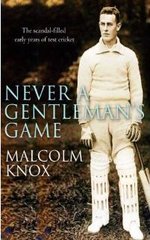Never a Gentleman’s Game
Archie Mac |Published: 2012
Pages: 442
Author: Knox, Malcolm
Publisher: Hardie Grant Books
Rating: 4 stars

Those unfamiliar with the details, if they are lucky enough to read Mr Knox’s book, will start with the best. Analytical, detailed and impeccably researched.
I lifted the above from my review of Malcolm Knox’s Bradman’s War, though the same description would fit aptly for his latest book, Never a Gentleman’s Game. The book covers cricket from Australia’s first Test match in 1877 through to the Triangular Tournament just before the Great War.
The entire 35 year period covered defines modern cricket from the number of players that form a tour party to the number of Tests played in a series, but further it sets the way cricket is run in Australia. The battle for control of money is the occurring theme throughout the book, which in turn is the battle between the players and what is now known as Cricket Australia (CA).
The battle for money, and particularly control of the lucrative tours of England, leaves most of the administrators and a few of the players in less than a flattering light. One former player comes out as not much more than a petulant money grabbing scrooge. The player is William Murdoch – perhaps his surname just equates to greed – despite earning a substantial profit from a tour of England, he refused to play Tests against the next England tourists to visit Australia. Murdoch wanted a far greater share of the gate then even the poor professionals of the Mother Country were paid when Australia toured England.
Murdoch’s attitude ruined one tour and hugely impacted on subsequent tours of Australia. As the tours were privately arranged by professional English cricketers his action, which to be fair appear to be an aberration with his subsequent behavior, almost stopped Ashes cricket for all time.
There does not seem to appear to be one controversy or interesting anecdote from the period that the author has missed. The only criticism, and it is a minor one, is some readers may develop the wrong impression of events due to their brevity of coverage in the book. One incident involves Charles Turner and his inability to tour England in 1896. The book gave the impression that Turner simply declined to tour, which on its face is correct, but there was more to the story than his simply turning down the offer made to him. He had in fact agreed to tour, but was not happy with being told which ship to catch, and in typical stubborn Turner behavior had a dummy spit.
This is undoubtedly the best book written on the period covered, and should be on every cricket lovers bookshelf. Yet again I am envious of those who have not read about this fascinating period of Australian cricket. They have much enjoyable reading here, although half a star is lost for the complete lack of illustrations in the book; unforgivable.
I am not sure how many copies this book will sell, but let’s hope it is a best seller, and we can have more books covering periods of cricket which in all honesty make things such as the controversy in say the IPL, a bore by comparison.






Leave a comment